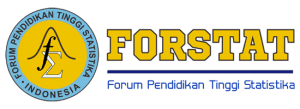PENGUJIAN HIPOTESIS SIMULTAN MODEL REGRESI NONPARAMETRIK SPLINE TRUNCATED DALAM PEMODELAN KASUS EKONOMI
Abstract
Keywords
Full Text:
PDFReferences
Astiti, D. A.W., Sumarjaya, I. W., and Susilawati, M. (2016), “Analisis Regresi Nonparametrik Spline Multivariat untuk Pemodelan Indikator Kemiskinan di Indonesia,” E-Jurnal Matematika, Vol. 05, pp. 111-116.
Badan Pusat Statistik. (2016). Analisis Kemiskinan, Ketenagakerjaan, dan Distribusi Pendapatan. Jakarta: BPS.
Badan Pusat Statistik. (2020). Laju Pertumbuhan Ekonomi PDB/PDRB. Available: [https://sirusa.bps.go.id/sirusa/index.php/indikator/3].
Badan Pusat Statistik. (2020). Tingkat Pengangguran Terbuka. Available: [https://sirusa.bps.go.id/sirusa/index.php/indikator/44].
Budiantara I. N., Ratna, M., Zain, I. and Wibowo, W., (2011), “Infants Weight Growth Model in Surabaya (Indonesia) by Using Weighted Spline Regression,” International Journal of Basic & Applied Sciences 11, pp 151-155.
Budiantara, I. N. (2019), Regresi Nonparametrik Spline Truncated, Surabaya: ITS Press.
Damaliana, A. T., Budiantara, I. N., and Ratnasari, V. (2019), “Comparing between m-GCV and a-GCV Methods to Choose the Optimal Knot Points in Semiparametric Regression with Spline Truncated Using Longitudinal Data,” 9th Annual Basic Science International Conference. IOP Publishing, pp. 01-10.
Eubank, R. L. (1999), Nonparametrik Regression and Spline Smoothing Edition 2, New York: Mercel Deker.
Fernandes, A. A. R. (2016), “Truncated Spline for Estimating the Curve of Nonparametric Regression Bi-Responses for Prediction the Inflation and Economic Growth in Malang Indonesia 2001-2005,” International Journal of Social Relevance & Concern, Vol. 05, pp. 26-32.
Fitriyani, N., Budiantara, I. N., Zain, I., and Ratnasari, V. (2016), “Nonparametric Regression Spline in The Estimation of The Average Number of Children Born Alive Per Woman,” The 1st International Conference on Science and Technology, pp. 169-172.
Memmedli, M. and Nizamitdinov, A. (2012), “An Application of Various Nonparametric Techniques by Nonparametric Regression Splines,” The International Journal of Mathematical Models and Methods in Applied Sciences, Vol. 06, pp. 106-112.
Pratiwi, L. P. S. (2017), “Pemodelan Spline Truncated dalam Regresi Nonparametrik Birespon”, Makalah Peserta pada Konferensi Nasional Sistem dan Informatika 2017, STMIK STIKOM Bali, Denpasar.
Setiawan, R. N. S., Budiantara, I. N, and Ratnasari, V. (2017), “Application of Confidence Intervals for Parameters of Nonparametrik Spline Truncated Regression on Index Development Gender in East Java,” Journal of Science, Vol. 02, No. 3, pp. 49-55.
Suparti, Prahutama, A., and Santoso, R., (2018), “Mix Local Polynomial and Spline Truncated: The Development of Nonparametric Regression Model,” IOP Conf. Series: Journal of Physics: Conf. Series 1025 012102.
Tikson, Deddy T. (2005), Teori Pembangunan di Indonesia, Malaysia dan Thailand, Makassar: Ininnawa.
Wahba, G. (1990), Spline Models for Observational Data, Pennsylvania: SIAM.
Yanthi, N. P. D., and Budiantara, I. N. (2016), “Pemodelan Faktor-Faktor yang Mempengaruhi Indeks Pembangunan Manusia Menggunakan Regresi Nonparametrik Spline di Jawa Tengah,” Jurnal Sains Dan Seni ITS, Vol. 05, No. 02.
DOI: https://doi.org/10.34312/jjps.v1i2.7755
Refbacks
- There are currently no refbacks.
Copyright (c) 2020 Jambura Journal of Probability and Statistics

This work is licensed under a Creative Commons Attribution-NonCommercial 4.0 International License.







.jpg)






